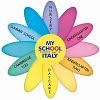Our selection is based on the following observation by the world famous researcher:
"All toys are learning toys," writes Kathy Hirsch-Pasek. The Temple University professor has written several books on the topic, such as Play = Learning.
"...but,” she continues, “ the toys that work best” :
"All toys are learning toys," writes Kathy Hirsch-Pasek. The Temple University professor has written several books on the topic, such as Play = Learning.
"...but,” she continues, “ the toys that work best” :
- are 90 percent child and 10 percent toys
- can be used in multiple ways - again and again
- inspire creativity and imagination
- can be used with others
Her message: Simpler is smarter. High-tech, high-cost gizmos with digital bells-and-whistles aren't necessary to elevate your child's intelligence. Instead, Hirsh-Pasek recommends traditional, vintage toys for Santa's list, such as rubber balls, clay, crayons, art supplies, building blocks, and other construction toys that enlist children's imaginations and small-motor skills to build castles, forts, and playhouses. Basics are best.
At My School ITALY KINDERGARTEN, we follow the advice given by Stanford University’s Bing Nursery School, a research laboratory for child development psychologists. Its Director Jeanne W. Lepper has a list of materials that help young children learn, including paper, pencils, crayons, scissors, glue, tape, cardboard boxes, easel paints, water colors, sand, play dough, building blocks, Legos, puzzles, dress-up clothes, hats, props, dolls, doll clothes, and simple musical instruments.








No comments:
Post a Comment